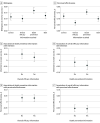Assessment of Communication Strategies for Mitigating COVID-19 Vaccine-Specific Hesitancy in Canada
- PMID: 34591105
- PMCID: PMC8485173
- DOI: 10.1001/jamanetworkopen.2021.26635
Assessment of Communication Strategies for Mitigating COVID-19 Vaccine-Specific Hesitancy in Canada
Abstract
Importance: Ensuring widespread uptake of available COVID-19 vaccinations, each with different safety and efficacy profiles, is essential to combating the unfolding pandemic.
Objective: To test communication interventions that may encourage the uptake of less-preferred vaccines.
Design, setting, and participants: This online survey was conducted from March 24 to 30, 2021, using a nonprobability convenience sample of Canadian citizens aged 18 years or older, with quota sampling to match 2016 Canadian Census benchmarks on age, gender, region, and language. Respondents completed a 2-by-2-by-2 factorial experiment with random assignment of brand (AstraZeneca or Johnson & Johnson), information about the vaccine's effectiveness against symptomatic infection (yes or no), and information about the vaccine's effectiveness at preventing death from COVID-19 (yes or no) before being asked about their willingness to receive their assigned vaccine and their beliefs about its effectiveness.
Exposures: Respondents were randomly assigned a vaccine brand (AstraZeneca or Johnson & Johnson) and information about the vaccine's effectiveness against symptomatic COVID-19 infection (yes or no) and at preventing death from COVID-19 (yes or no).
Main outcomes and measures: Respondents' self-reported likelihood of taking their assigned vaccine if offered (response categories: very likely, somewhat likely, not very likely, or not at all likely, scaled 0-1) and their beliefs about their assigned vaccine's effectiveness (response categories: very effective, somewhat effective, not very effective, or not at all effective, scaled 0-1) were measured.
Results: A total of 2556 Canadian adults responded to the survey (median [IQR] age, 50 [34-63] years; 1339 women [52%]). The self-reported likelihood of taking an assigned AstraZeneca or Johnson & Johnson vaccine was higher for respondents given information about their assigned vaccine's effectiveness at preventing death from COVID-19 (b, 0.04; 95% CI, 0.01 to 0.06) and lower among those given information about its overall effectiveness at preventing symptomatic transmission (b, -0.03; 95% CI, -0.05 to 0.00), compared with those who were not given the information. Perceived effectiveness was also higher among those given information about their assigned vaccine's effectiveness at preventing death from COVID-19 (b, 0.03; 95% CI, 0.01 to 0.05) and lower among those given information about their assigned vaccine's overall efficacy at preventing symptomatic infection (b, -0.05; 95% CI, -0.08 to -0.03), compared with those who were not given this information. The interaction between these treatments was neither substantively nor statistically significant.
Conclusions and relevance: These findings suggest that providing information on the effectiveness of less-preferred vaccines at preventing death from COVID-19 is associated with more confidence in their effectiveness and less vaccine-specific hesitancy. These results can inform public health communication strategies to reduce hesitancy toward specific COVID-19 vaccines.
Conflict of interest statement
Figures


Similar articles
-
Factors Associated With US Adults' Likelihood of Accepting COVID-19 Vaccination.JAMA Netw Open. 2020 Oct 1;3(10):e2025594. doi: 10.1001/jamanetworkopen.2020.25594. JAMA Netw Open. 2020. PMID: 33079199 Free PMC article.
-
Perceived COVID-19 vaccine effectiveness, acceptance, and drivers of vaccination decision-making among the general adult population: A global survey of 20 countries.PLoS Negl Trop Dis. 2022 Jan 28;16(1):e0010103. doi: 10.1371/journal.pntd.0010103. eCollection 2022 Jan. PLoS Negl Trop Dis. 2022. PMID: 35089917 Free PMC article.
-
COVID-19 vaccine hesitancy in a representative working-age population in France: a survey experiment based on vaccine characteristics.Lancet Public Health. 2021 Apr;6(4):e210-e221. doi: 10.1016/S2468-2667(21)00012-8. Epub 2021 Feb 6. Lancet Public Health. 2021. PMID: 33556325 Free PMC article.
-
Potential factors influencing COVID-19 vaccine acceptance and hesitancy: A systematic review.PLoS One. 2022 Mar 23;17(3):e0265496. doi: 10.1371/journal.pone.0265496. eCollection 2022. PLoS One. 2022. PMID: 35320309 Free PMC article.
-
COVID-19 vaccine hesitancy in South Africa: how can we maximize uptake of COVID-19 vaccines?Expert Rev Vaccines. 2021 Aug;20(8):921-933. doi: 10.1080/14760584.2021.1949291. Epub 2021 Jul 12. Expert Rev Vaccines. 2021. PMID: 34252336 Review.
Cited by
-
Unwillingness or reluctance of Palestinians to get the COVID-19 vaccine: the reasons behind it and how to persuade them.Int J Infect Dis. 2022 Jun;119:53-55. doi: 10.1016/j.ijid.2022.03.039. Epub 2022 Mar 25. Int J Infect Dis. 2022. PMID: 35346835 Free PMC article.
-
From institutional trust to digital literacy: Socioeconomic and political determinants of COVID-19 vaccine hesitancy among Czech adults based on a national panel survey.Hum Vaccin Immunother. 2025 Dec;21(1):2533639. doi: 10.1080/21645515.2025.2533639. Epub 2025 Jul 15. Hum Vaccin Immunother. 2025. PMID: 40665470 Free PMC article.
-
Unpacking the Implications of SARS-CoV-2 Breakthrough Infections on COVID-19 Vaccination Programs.Vaccines (Basel). 2022 Feb 7;10(2):252. doi: 10.3390/vaccines10020252. Vaccines (Basel). 2022. PMID: 35214710 Free PMC article.
-
Which vaccine attributes foster vaccine uptake? A cross-country conjoint experiment.PLoS One. 2022 May 4;17(5):e0266003. doi: 10.1371/journal.pone.0266003. eCollection 2022. PLoS One. 2022. PMID: 35507554 Free PMC article.
-
Effect of inactivated COVID-19 vaccination on intrauterine insemination cycle success: A retrospective cohort study.Front Public Health. 2022 Sep 12;10:966826. doi: 10.3389/fpubh.2022.966826. eCollection 2022. Front Public Health. 2022. PMID: 36172215 Free PMC article.
References
-
- Motta M. President Trump promised a COVID vaccine by Election Day: that politicized vaccination intentions. In: Jackson D, Coombs DS, Trevisan F, Lilleker D, Thorse E, eds. U.S. Election Analysis 2020: Media, Voters and the Campaign. The Centre for Comparative Politics and Media Research, Bournemouth University; 2020:18-19.
Publication types
MeSH terms
Substances
LinkOut - more resources
Full Text Sources
Medical

